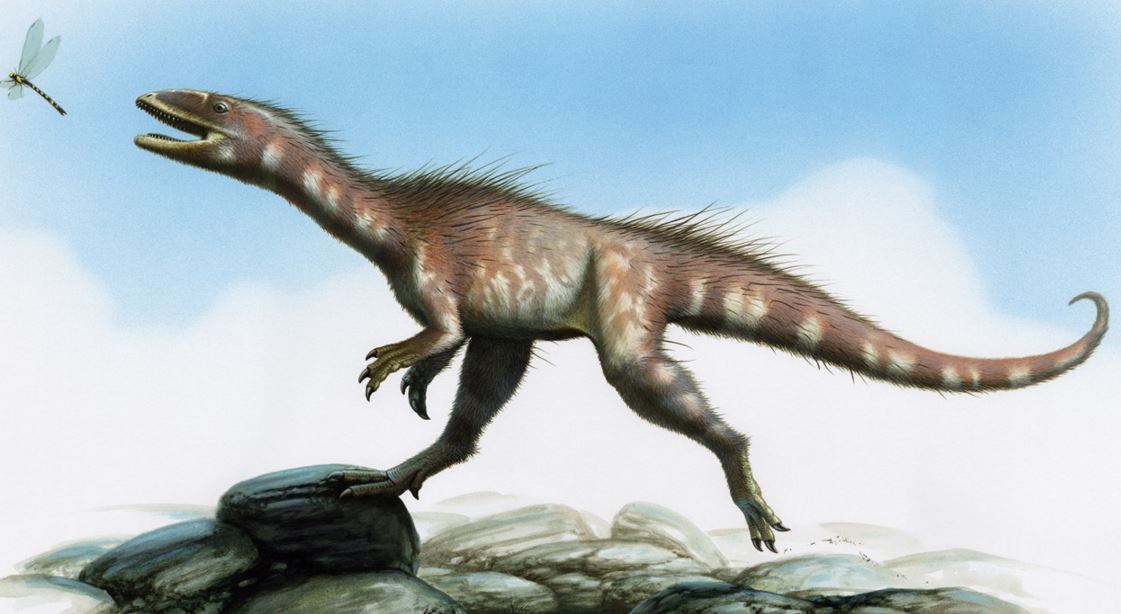Dragon Thief (Dracoraptor), the earliest Jurassic dinosaur skeleton ever found, was discovered by fossil-hunting brothers Nick and Rob Hanigan after a beach fall at a cliff in Wales. Twelve months later, palaeontology student Sam Davies, from the University of Portsmouth, discovered a fossilised foot during a field trip at exactly the same spot.
A team of palaeontologists from the University of Portsmouth, the National Museum Wales, and the University of Manchester, describe the dinosaur in the academic journal PLOS ONE.
Dr. David M. Martill, who works at the University of Portsmouth’s School of Earth and Environmental Sciences, and colleagues concluded that Dragon Thief was a very distant cousin of Tyrannosaurus rex and existed more than 200 million years ago at the very beginning of the Jurassic period.
 A rendition of the Dracoraptor by artist Bob Nicholls. (Image: port.ac.uk. Credit: National Museum Wales)
A rendition of the Dracoraptor by artist Bob Nicholls. (Image: port.ac.uk. Credit: National Museum Wales)
Dracoraptor named by brothers who discovered it
Dr. Martill, a reader in palaeobiology, said:
“We invited Rob and Nick to name this beautiful little dinosaur and they suggested ‘Dracoraptor’ after draco meaning dragon, the national symbol of Wales, and raptor meaning thief or plunderer.”
“The draco part of the name seemed fitting because the fossils were found in Wales and will be displayed in Wales, reflecting the red dragon of the Welsh flag. Dracoraptor was a meat-eating dinosaur that would have used its small needle-sharp teeth with steak-knife serrations to pinch bits of meat here and there, hence the part of its name meaning thief.”
“Although the Hanigan brothers chose the generic name we also wanted to credit them, which is why the full name of the species is in fact Dracoraptor hanigani.”
 Dr. Dave Martill with Sam Davies, his palaeontology student. (Image: port.ac.uk)
Dr. Dave Martill with Sam Davies, his palaeontology student. (Image: port.ac.uk)
The fossilised bones, including claws, teeth, skull and a foot, were unearthed on a beach near Penarth in the Vale of Glamorgan. The specimens have been donated to the National Museum Wales.
The fossils were found spread across five slabs of rock. While some were preserved in the correct position, others had been moved about by the actions of scavenging sea-urchins and fish.
Dragon Thief was a juvenile
Experts say the dinosaur was a juvenile, as many of its bones appeared not to be fully formed.
Dr. Martill said:
“This animal was small, slim and agile – probably only around 70 cm tall and 200 cm long – the size of a leopard or a cheetah maybe. It also had a long tail to help it balance.”
 (A) The base of the Jurassic showing alternating limestone and mudstone series. The new specimen is most likely from the higher of two limestones indicated in yellow that contain a thin shelly horizon.It was recovered from the fallen blocks in front of the exposure. (B) The same beds in stratigraphic context with the highest occurrence of conodonts. (Image: journals.plos.org)
(A) The base of the Jurassic showing alternating limestone and mudstone series. The new specimen is most likely from the higher of two limestones indicated in yellow that contain a thin shelly horizon.It was recovered from the fallen blocks in front of the exposure. (B) The same beds in stratigraphic context with the highest occurrence of conodonts. (Image: journals.plos.org)
Mr. Davies’ chance discovery of the foot would not have occurred had he arrived later. The fossil, which had been found sitting on top of a slab of rock, would have been taken away by the tide of the River Severn.
Dr. Martill said:
“Sam’s discovery of the foot of Dracoraptor on the Severn estuary really was the most remarkable and serendipitous discovery and it’s wonderful that it will now be displayed with the rest of the specimen in the National Museum Wales, in Cardiff.”
This is the first skeleton of a theropod dinosaur ever found in Wales. Previously, isolated bones and teeth had been unearthed in south Wales near Cowbridge, Penarth and Bridgend. One of the earliest dinosaur footprint sites in Europe, dating back to 215 million years ago during the Middle Triassic, was found nearby at Barry.
However, Dracoraptor’s discovery is a major find compared to the scrappy bits and pieces found before.
David Anderson, Director General of the National Museum Wales (Amgueddfa Cymru) said:
“We’re very grateful to Nick and Rob Hanigan who have been incredibly generous in donating this wonderful specimen to the collection of Amgueddfa Cymru, to preserve it for future generations.”
“We are delighted to put this specimen back on display in the main hall. It proved to be very popular last year with the public and this time visitors will also be able to see another recent discovery which is the foot of the dinosaur. I hope people take this opportunity to find out more about this fascinating new dinosaur species which was discovered here in south Wales and dates back 200 million years.”
Citation: “The Oldest Jurassic Dinosaur: A Basal Neotheropod from the Hettangian of Great Britain,” David M. Martill , Steven U. Vidovic, Cindy Howells and John R. Nudds. PLOS ONE. Published 20 January, 2016. DOI: 10.1371/journal.pone.0145713.
Video – Dracoraptor Extras
Dr. Martill discusses which parts of the Dracoraptor skeleton have been found.
